Note: I’ll use “we” when I’m confident I can represent both Tzu and me, and I’ll use “I” when it’s mostly Yi-Yang’s opinion. All mistakes are Yi-Yang’s.
1. How did EA MY do?
Before we give our results, here are some helpful context:
- When we applied for the grant, we made some predictions about our targets (see appendix). Unfortunately, our predictions for existing members weren’t that helpful since (a) we incorrectly gave many of them the wrong categories and (b) we’ve lost track of some of the members.
- We used “Categories” (shortened to Cat) to label folks their engagement levels (which is somewhat similar to the funnel model). This was based on the EA Groups Survey in 2020 and I’ve made some light modifications. If you’re not familiar, I would encourage you to skim this list before proceeding or the next section wouldn’t make much sense.
- We looked at both (a) the absolute change in Cat and (b) the counterfactual change in Cat between August 1st, 2021 and January 31st, 2022.
- In terms of absolute changes, we looked at what Cat a member is before August, and what cat they are at around the middle of January (see appendix). We don’t think it gives an accurate picture of EA MY’s influence on our members’ actions, but it does give a good impression of community engagement levels in EA MY. Please take note that most of our engaged members are not in Malaysia.
- In terms of counterfactuals, we asked our members what they would be doing if EA MY didn’t exist, and compared that with what they had done in the past six months. We think looking at counterfactuals is likely to show a truer picture of EA MY’s influence on our members’ actions, and that’s what we’re focusing on for our results.
- We spent a total of 280 hours for 26 weeks, which is about 10.8 hours per week.
Now to our results, My guess is that EA MY isn’t as successful when compared to other groups, even after controlling for many factors (e.g. GDP, population size, starting engagement levels, hours spent, etc). But we still had some pretty good counterfactual results in the past six months:
- We got 6 people out of 43 (14%), who would have been Cat 0, to move to Cat 1.5 and above.
- We got 2 people out of 5 (40%), who would have been Cat 1, to move to Cat 1.5 and above.
- We got 3 people out of 10 (30%), who would have been Cat 1.5, to move to Cat 2.
- We got 1 person out of 2 (50%), who would have been Cat 2, to move to Cat 3.
You can find out more about our counterfactual results with our cool Sankey diagram in the appendix.
2. What was EA MY’s plan?
Here’s a breakdown:
- For existing members, we wanted to keep doing what we’ve been doing already, and here’s what we’ve done.
- 2 virtual socials and 1 in-person social
- 4 community 1-1s
- Managed our online forums (e.g. sign-posting opportunities and events, nudging people to register)
- For outreach, we wanted to test a bunch of targeted outreach events in communities that might be interested in EA, then get them to an introductory program. Here’s what we’ve done:
- 2 targeted outreach events at EA-adjacent communities
- 3 targeted outreach events at student groups
- 1 targeted outreach event at a corporation
- 14 introductory 1-1s
- Facilitated 3 participants who completed EA VP’s Introductory EA Program
- Facilitated 8 participants who completed EA MY’s Seminar Programme
- Manage our social media accounts
3. What could have been better?
- Yi-Yang spent too much time on crafting a new presentation (~30 hours) and developing an onboarding document (~20 hours). We could probably have been leaner and tested our outreach plans more.
- Tzu was committed to too many projects.
- We didn’t do enough consistent “low cost” meetups.
- There was some confusion over funding that we spent a lot of time on.
4. What went well?
- We managed to follow through with most of our plans despite both being busy people.
- All the activities we’ve done above were likely to be at least a 7 out of 10 star rating (according to Yi-Yang’s own impression), and there were no major issues that popped up.
- Most of our members think we did well (N = 20):
- How likely is it that you would recommend EA Malaysia…? - average 9/10
- How much do you feel like you belong in the effective altruism community? - average 7/10
- Targeted outreach towards the following groups have been fruitful:
- USAPPS - a yearly event that supports Malaysian students to apply to US universities
- Malaysian Philosophy Society - has a yearly conference that hosts a number of philosophical talks
5. What are EA MY’s plans?
For the remainder of 2022, I think what we absolutely want to avoid is doing nothing when we have some momentum going on already. The difference in the number of people taking more significant actions between 2019/2020 and 2021 has been huge.
However, Yi-Yang is hoping to step down soon and there aren’t any successors at this point.
Current options we are thinking of (not in particular order):
- Very low cost community building
- Continue looking for a successor
- Run outreach events that were successful last year
- Organise a retreat
Our plans are also highly dependent on how EA IF might want to fund EA MY too.
Appendix
1. Predictions
- Retention (80% confidence)
- 1 member from Category 0.5 will remain at Category 0.5
- 1 member from Category 1 will remain at Category 1
- 1 member from Category 1.5 will remain at Category 1.5
- 1 member from Category 2 will remain at Category 2
- 2 members from Category 3 will remain at Category 3
- 3 members from Category 4 will remain at Category 4
- Increase in engagement (80% confidence)
- 1 member from Category 0.5 will move to Category 1
- 1 member from Category 0.5 will move to Category 1.5
- 2 members from Category 1 will move to Category 1.5
- 2 members from Category 1.5 will move to Category 2
- 2 members from Category 2 will move to Category 3
- Outreach (80% confidence)
- At least 8 people from Cat 0 to Cat 1.5
2. Counterfactual results
Before | After |
Cat -1 | 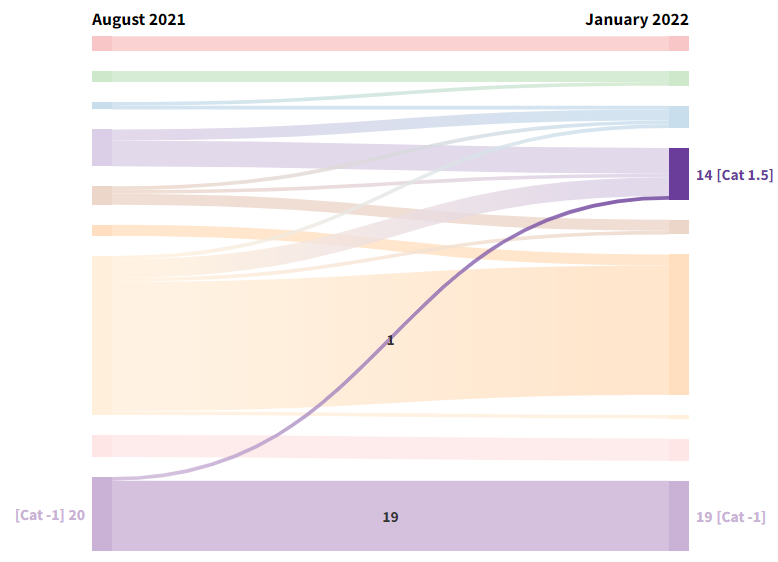 |
Cat -0.5 | 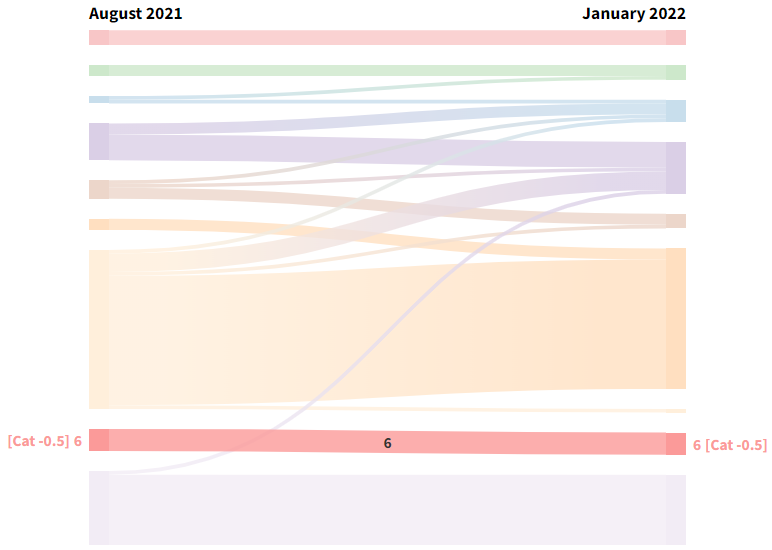 |
Cat 0 |  |
Cat 0.5 | 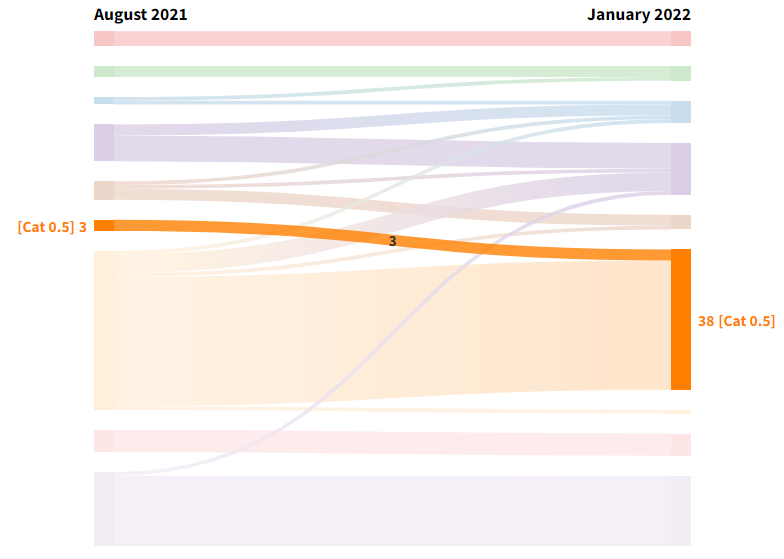 |
Cat 1 |  |
Cat 1.5 |  |
Cat 2 |  |
Cat 3 | 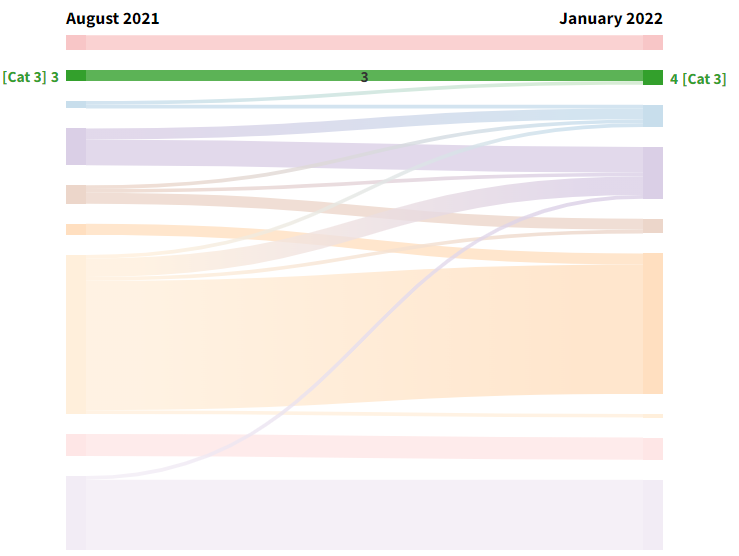 |
Cat 4 |  |
3. Absolute results

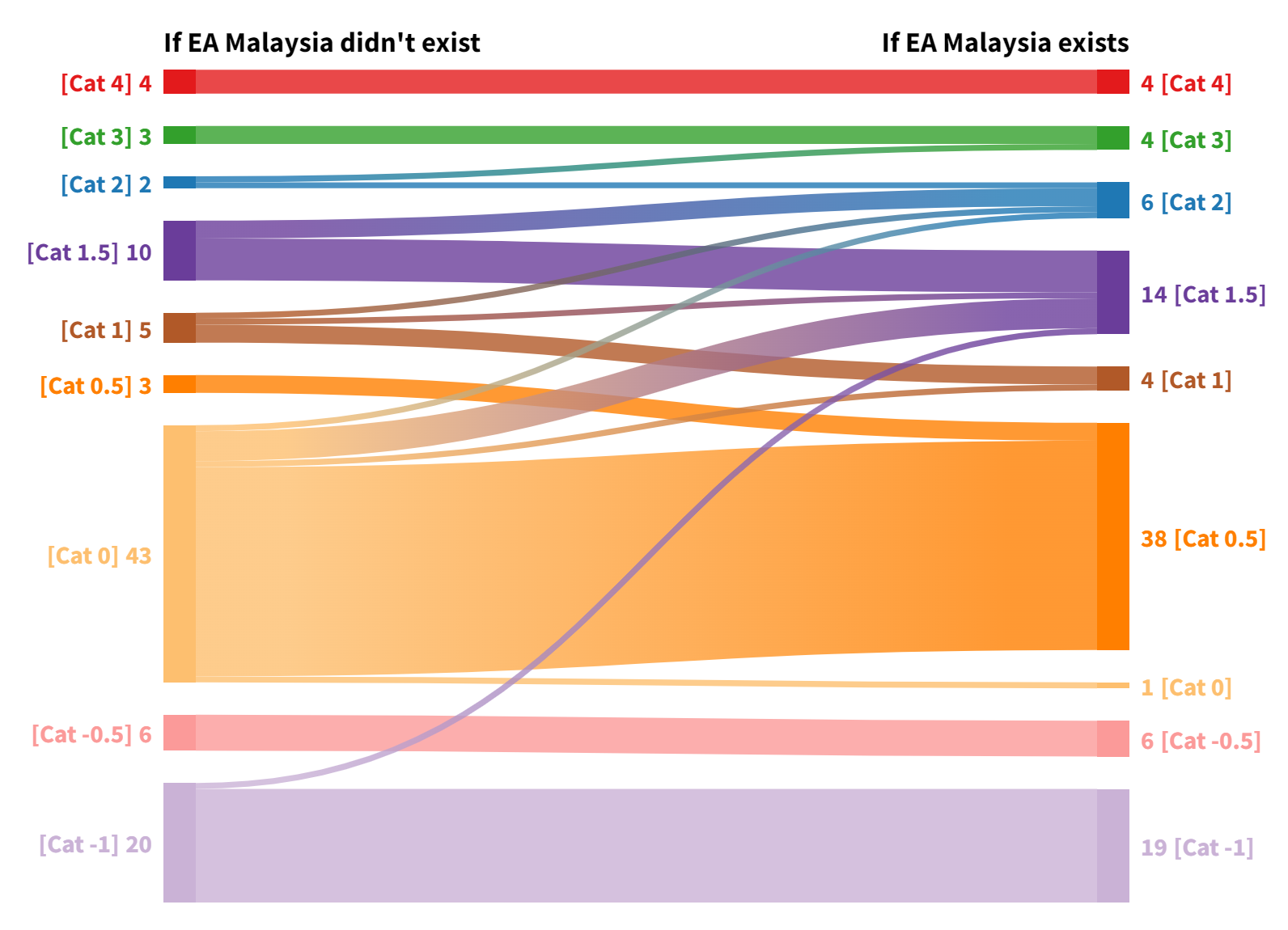
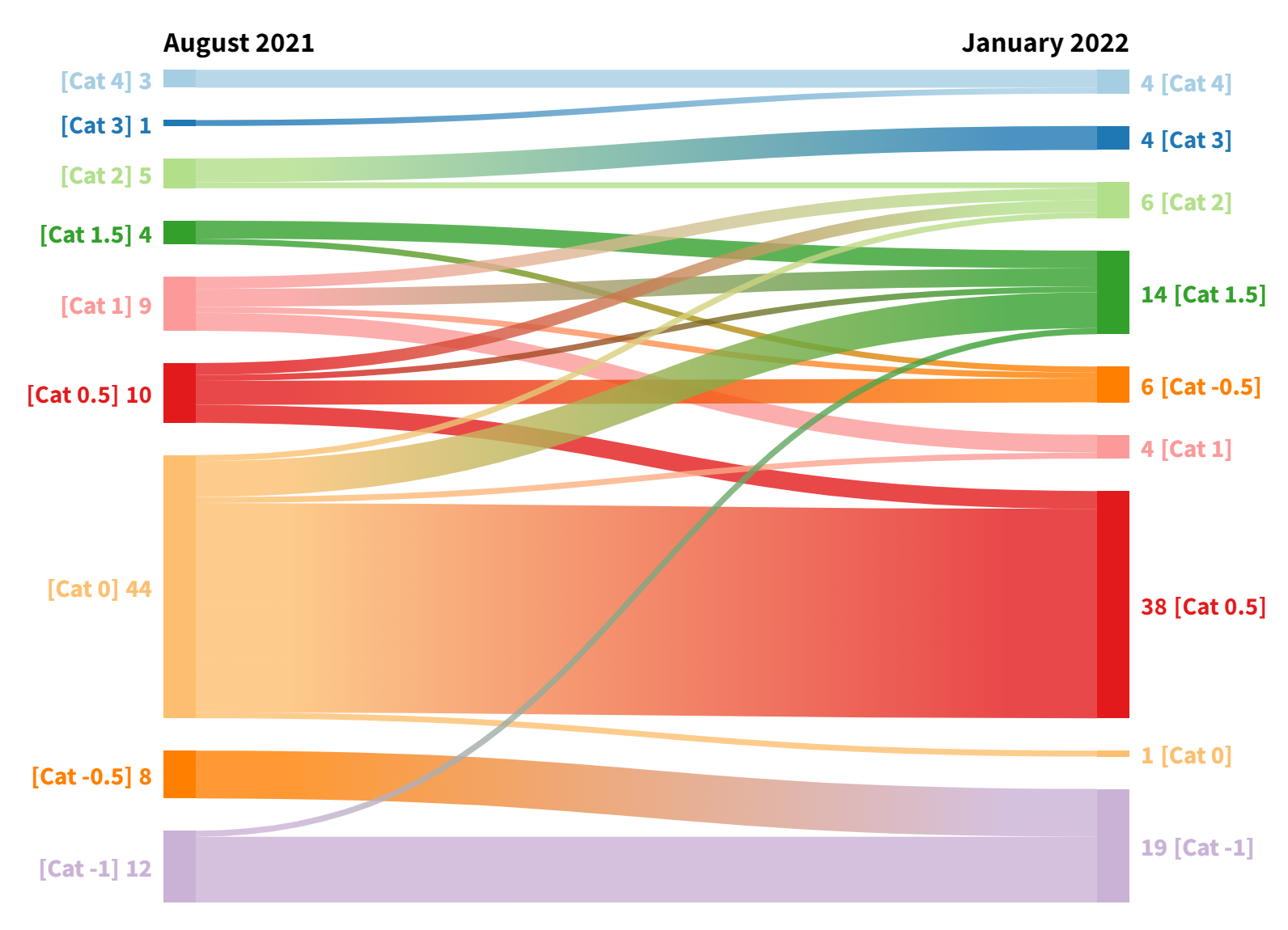
I like the diagram :) Best wishes for the remainder of 2022, and finding a successor! Is there any way others in EA not from EA MY can help you?
I like the Sankey diagram too - what did you use to make it Yi-Yang?
This! https://flourish.studio/visualisations/sankey-charts/
Possibly! Fingers crossed for that. :)
I also love this diagram and model for tracking progress. I will see about copying this for my EA group.
Regarding your next steps, my current hypothesis would be that the highest value items from your list are:
And hopefully 1 & 2 could surface a potential successor, or even just other community members who are willing to run events.
Oh interesting! I see a few examples of this when Googling. If you have a go-to resource for organising this, would love to check it out.
I'll DM you a contact (if others reading this are interested feel free to message as well!)
I resonate a lot with a lot of these bullets , I think I've done the first and second thing in the past, and definitely feel that consistency of meetups was important in increasing attendance in the EA Philly group when I was running it in 2019 / early 2020.
I'd love to know what a leaner version of our plans might have looked like and how it differed from what you ended up doing. I also wonder if there were ways you could have noticed that the projects were taking longer than optimal as you were doing them.
Less tailor-made events and more consistent simple meetups (socials, YT watch parties, etc).
Less tailor-made targeted outreach and more advertising.
Out of curiosity, what presentation did you spend too long on creating? I imagine it could be valuable for other group organisers.
(Also, really appreciate how quick and easy to read this report is, I'll split my thoughts over other comments).
An animal welfare one! But more heavily modified to an amateur philosophy audience.